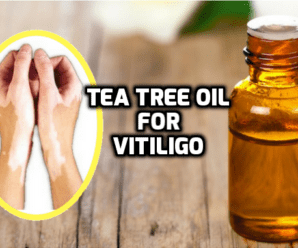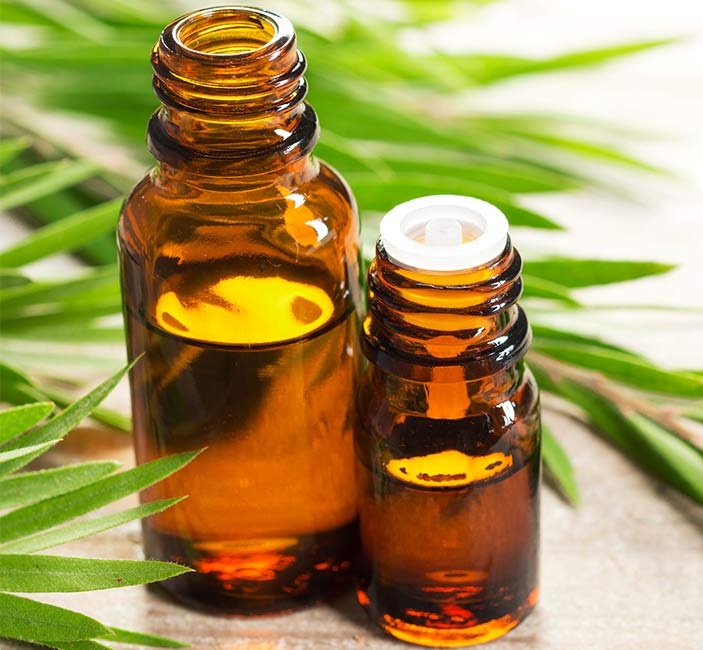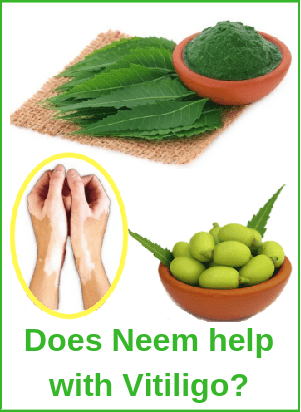
Does Tea Tree oil help with Vitiligo
Tea tree oil is a research proven antimicrobial and anti-inflammatory herbal oil which is widely used as a key ingredient in various skin and hair care products to treat acne, pimples, dandruff, lice, toenail fungus, ringworm, athlete’s foot and various types of skin fungal and bacterial infections.
But, does tea tree oil help with vitiligo?
I would say- not much, because vitiligo is a not a skin infection, rather it is an autoimmune skin condition which is linked to the internal body metabolism. Hence, applying tea tree oil on the white patches on the skin will not do much for you.
A quick intro about Tea tree oil
It is extracted from the leaves of ‘Melaleuca’ tree which is native to Australia and some parts of the Asia. (1) It is an essential oil with powerful anti-fungal, anti-bacterial, antiseptic and anti-inflammatory properties. (2) That’s why, it is frequently used as an active ingredient in shampoos, bathing bars, face wash, massage oils and foot and nail creams. Also, many household cleaning and laundry products contain tea tree oil.

Most of the antimicrobial properties of tea tree oil are attributed to ‘Terpinen-4-ol’, the major constituent of tea tree oil. It is a a terpene, volatile in nature, with capability to kill harmful bacteria, fungi and viruses. (2) It works by destroying the cell membrane structures of harmful microorganisms. (3)
Tea tree oil is the most frequently recommended essential oil to treat fungal skin infections.
Pharmacological actions of tea tree oil (2, 4)
- Anti-bacterial
- Anti-fungal
- Anti-viral
- Antiprotozoal
- Anti-inflammatory
- Anti-oxidant
- Antiseptic
- Wound healing
Some research evidences
I have found 468 research studies discussing the antimicrobial properties of tea tree oil. (5) It is not possible to discuss them all here. Hence, just sharing a few interesting ones with you as below:
- At the same concentration (5%), tea tree oil is as effective as benzoyl peroxide (a pharma drug formulation) in treating acne with far less side effects. (6)
- Tea tree oil has anti-fungal action against Candida Albicans and related strains of harmful fungi. (7) Candida is a fungal infection on the skin due to yeast overgrowth.
- Tea tree oil inhibits and kills various groups of fungi that can cause skin diseases in humans and animals. (8)
- Tea tree oil is almost 20 times more powerful than garlic in killing harmful oral microorganisms. (9) However, oral consumption of tea tree oil can be dangerous. Hence, doctor’s consultation is strictly recommended before using tea tree oil solution as a mouthwash.
- A review published in the Indian Journal of Dermatology discussed the use of tea tree oil as a broad spectrum antimicrobial herbal formulation which can be used to treat acne vulgaris, seborrheic dermatitis and scabies. Also, it has wound healing and anti-skin cancer activity. (10)
Vitiligo is an autoimmune skin condition and autoimmunity is not a skin infection
Vitiligo, also called as leucoderma, is not a skin infection, but, an autoimmune skin disorder. The immune system is body’s first line of defense that protects the body against harmful microorganisms. But, in case of autoimmunity, the immune system gets faulty and confused and starts attacking the body’s own skin cells. It attacks the pigment (color) producing skin cells and destroy them. It results in skin de-pigmentation in the form of white patches on various areas of the skin.
The exact reason for such a strange behavior of the immune system is unknown, but, the most commonly discussed causes are:
- Chronic stress
- Poor gut health (gut is the whole digestive tract that starts at the mouth and ends at the anus)
- Hereditary (genetic)
- Internal body infections such as strep throat
- Skin injuries
- Overuse of antibiotics and steroids
- Alcohol abuse
- Poor diet and lifestyle habits
- Nutritional deficiences
- Heavy metals toxicity due to contaminated water or pesticides in the food
Bottom line– Being an autoimmune disorder, vitiligo is not just a skin problem. It is an internal body related problem. The white patches on the skin are just a reflection that everything is not fine inside your body. Hence, no oil, cream or any other external treatment can treat vitiligo.
Autoimmune problems are healed by improving gut health
Do you know that more than 70% of the immune system is located in the gut. (11) It means- you can’t get long term relief in autoimmune problems without improving the gut health. That’s why, the natural (holistic) healing works on the principle that all autoimmune problems being in the gut and their treatment also lies in the gut only.
A healthy, optimum gut health means:
- Smooth elimination of body toxins- no constipation, no accumulation of undigested food in the gut
- Optimum digestion- no gas, bloating, acid reflux or any other signs of digestive discomfort.
- Optimum gut flora- balance of good gut microbes (probiotics) and bad gut microbes (pathogens)
- Healthy liver functioning
The holistic healing of vitiligo has 6 main pillars:
- Internal body cleansing and body detox
- Restricted, healthy diet
- Healthy, positive lifestyle
- Stress management with the help of Yoga, meditation and regular exercise
- Consuming dietary supplements like vitamin D, Omega 3 fats, vitamin B12, zinc, selenium, glutamine etc.
- Anti-oxidant and anti-inflammatory natural herbs like turmeric (curcumin), milk thistle, triphala etc.
Why tea tree oil is useful for other autoimmune skin conditions like Psoriasis and Eczema
As we have just discussed, tea tree oil doesn’t show much promise in vitiligo treatment. But, it is frequently used to manage symptoms of other autoimmune skin disorders like psoriasis and eczema.
Psoriasis and eczema are characterized by itching, skin dryness, inflammation and dry skin scales falling off the skin, particularly the scalp. In these skin conditions, applying tea tree oil mixed with virgin coconut oil on the affected skin areas can help by reducing itching, skin inflammation and scaling problem.
But, in case of vitiligo, symptoms like skin dryness, itching and inflammation are very mild. You may feel mild sunburn and itching on vitiligo affected areas if you stay in sunlight for long; other than that, vitiligo is quite free from itching or skin inflammation. Thus, applying tea tree oil on white spots on skin would not bring any immediate relief as such.
Tea tree oil for Vitiligo- To use or not to use
Well, it’s upon you to decide; I have explained everything to you. Tea tree oil application on vitiligo patches will not do any magic. As a matter of fact, no external application can treat vitiligo unless you improve the inner body health.
But, if you want to try, no harm in it unless you overuse it. If you can’t tolerate sun exposure for long duration, then adding a few drops of tea tree oil in your body massage oil will definitely provide some anti-inflammatory effect to reduce the skin burning sensation.
How to use Tea tree oil
Pure (concentrated) tea tree oil is highly potent and can cause skin burn if applied directly on the skin. Always mix it with a carrier oil such as virgin coconut oil or olive oil. The virgin coconut oil is the purest form of coconut oil which is a wonderful natural sunscreen with powerful antimicrobial properties. It can moisturize and nourish your skin well if used regularly. I have already written a detailed article on the benefits of virgin coconut oil for vitiligo.
If you are already using any oil or cream for vitiligo, then you can mix a few drops of tea tree oil in that also.
How much tea tree oil to use?
To be on the safer side, never go beyond 5% concentration of tea tree oil. It means, 30 drops of tea tree oil in 1 ounce (30 ml) of virgin coconut oil. In terms of teaspoons, add half teaspoon of tea tree oil in 6 teaspoons of virgin coconut oil.
For application, simply take this oil mixture and massage on the vitiligo affected areas as usual. If you feel any irritation or burning sensation, you can dilute the oil solution with more coconut oil.
Safety precautions
- Internal consumption of tea tree oil is not recommended as it can prove toxic. (12) Also, you should be extra careful if applying tea tree oil in or around the mouth.
- External application of tea tree oil is quite safe unless you are allergic to it. To check if you are allergic to tea tree oil, add 2 drops of tea tree oil in half teaspoon of coconut oil (or any oil). Apply small amount of this oil mixture on the inner forearm and observe if it causes severe skin redness or skin burn. Don’t worry about mild burning sensation as it is the very ‘nature’ of tea tree oil, but, if it is severe, then you better avoid tea tree oil.
From where to buy
Check below Amazon links to buy 100% pure, natural ‘Australian’ tea tree oil for a reputed brand:
If you are from USA, click here to check
If you are from India, click here to check
If you are from UK, click here to check
Need more help?
Please ask your queries related to vitiligo from Dr Rekha Jain. Send her an email at [email protected].



